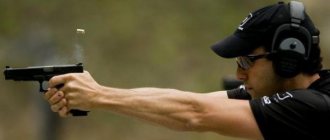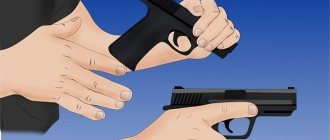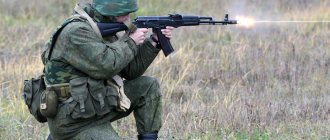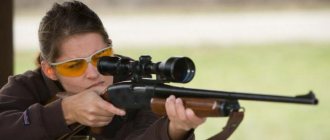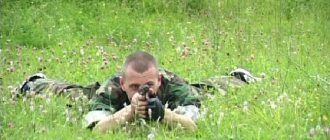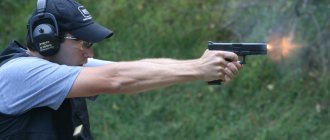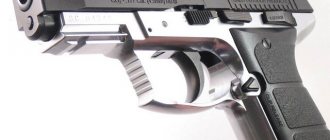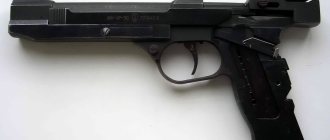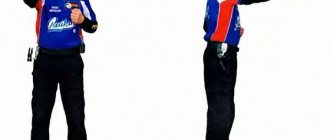so UNT / Textbooks on CVP / Textbook on CVP for 10th grades of secondary schools (Mektep 2010)
§4.5 Stop shooting
The cessation of shooting can be temporary or complete.
To temporarily stop shooting, the command “Stop!” is given, and when shooting in motion - “Cease fire!” Following these commands, the machine gunner (machine gunner) stops pressing the trigger, puts the machine gun (machine gun) on safety and, if necessary, changes the magazine.
To change the store you need:
— separate the magazine from the machine gun (machine gun);
— attach a loaded magazine.
If all the cartridges in the magazine have been used up, then after attaching the loaded magazine to the machine gun (machine gun), you need to remove the machine gun (machine gun) from the safety lock, bring the bolt frame back by the handle until it stops, release it and put the machine gun on the safety again.
To completely stop shooting after the command “Stop!” or “Cease fire!” The command “Discharge!” is given. At this command, the machine gunner (machine gunner) puts the machine gun (machine gun) on safety, pulls the clamp back, setting the machine gun’s sight to “P”, the machine gun’s sight to 1 and the rear sight to 0, unloads the machine gun (machine gun), and for a machine gun with a folding The butt also folds the butt. When shooting from a prone position, he lowers the butt (the back of the receiver) to the ground, and places the muzzle of the machine gun on the forearm of his left hand (Fig. 101) and then acts according to the situation.
When firing from a trench, after unloading, the machine gun can be placed on the parapet of the trench with the bolt handle downward.
To unload an assault rifle (machine gun) you need to:
— separate the store;
— remove the machine gun (machine gun) from the safety lock;
- slowly pull the bolt frame back by the handle, remove the cartridge from the chamber and release the bolt frame;
Rice. 101. Position of the machine gun after the ceasefire
Rice. 102. Execution of the command “Stand up!”: a—the position of the machine gunner before standing up; b — bringing the right (left) leg forward
— pull the trigger (decock the hammer);
- put the machine gun (machine gun) on the safety catch, take it to the “belt” position if shooting was carried out from a standing position, or put it on the ground if shooting was carried out from a prone position;
— remove the cartridges from the magazine and attach it to the machine gun;
- pick up the cartridge removed from the chamber.
To remove cartridges from the magazine, you need to take the magazine in your left hand with the neck up, the supporting protrusion towards you, with your right hand, pushing the cartridges one by one away from you, remove them from the magazine.
To stand up, you need to pull both arms up to chest level, holding the machine gun with your right hand by the fore-end and the barrel guard, at the same time bring both legs together (Fig. 102, a), sharply straightening your arms, lift your chest off the ground and extend your right (left) leg forward (Fig. 102, b), quickly stand up and, if necessary, start moving.
After unloading the machine gun magazine, if necessary, the commander gives the command “Weapon - for inspection!” With this command you need to:
— in a prone position: separate the magazine and place it near the machine gun (machine gun) with the neck facing you, remove the machine gun (machine gun) from the safety catch, pull the bolt frame back by the handle and turn the machine gun (machine gun) slightly to the left; after the commander has inspected the chamber and magazine, release the bolt frame forward, release the hammer (pull the trigger), put the machine gun (machine gun) on safety and attach the magazine to the machine gun (machine gun);
- in a standing position: holding the machine gun (machine gun) with your left hand from below by the fore-end, with your right, separate the magazine and transfer it to your left hand with the feeder up (the convex part away from you), with the fingers of your left hand, press the magazine to the forend of the machine gun (machine gun);
release the trigger (press the trigger), put the machine gun (machine gun) on safety, attach the magazine and take the machine gun (machine gun) to the “belt” position or to the leg.
Techniques for shooting from point-blank range and from behind cover
Depending on the height of the support or cover, the machine gunner (machine gunner) takes the following shooting positions: lying down, kneeling or standing.
To fire from a machine gun from a rest: place the machine gun with the fore-end on the rest and hold it with your left hand by the magazine or fore-end, and with your right hand by the pistol grip (Fig. 104, a, b).
To fire a machine gun from a rest: place the machine gun with the fore-end on the rest so that the rest does not interfere with the operation of the mechanisms; The legs of the bipod can hang freely in front of the stop (Fig. 104, c) or must be folded. However, machine gunners should always strive to use the bipod of the machine gun as a stop (Fig. 104, d). To soften the hard stop, cover it with turf, a rolled-up raincoat, a roll of an overcoat, etc.
To shoot from behind a tree, corner of a building, or other cover:
take a shooting position, lean against the cover so that
Rice. 104. Position when shooting from a rest: a - holding the machine gun by the magazine; b - holding the machine gun by the fore-end; c — firing from a machine gun without using a bipod; d — shooting from a machine gun using a bipod
Rice. 105. Position when firing from a machine gun from behind cover: a - from a standing position; b— from a lying position
it protected from enemy fire (Fig. 105); hold the machine gun (machine gun) in the same way as when shooting without cover (Fig. 104). When shooting from behind small cover (a trench for prone shooting, a hillock, a hummock), you need to position yourself behind the cover.
To shoot from a trench or trench: lean against the wall of the trench, rest the elbows of both hands on the ground, and press the butt tightly to the shoulder; in this case, shooting can be carried out both from a rest and from the hand or with the magazine resting on the ground (Fig. 105, 106).
Questions and tasks:
1. What actions does the machine gunner (machine gunner) perform to temporarily or completely stop firing?
2. State the procedure for unloading an assault rifle (machine gun).
3. What is the difference between the actions of a machine gunner (machine gunner) upon the command “Weapon - for inspection!” in standing and lying positions?
4. Tell us about the techniques of shooting from point blank range and from behind cover.
Rice. 106. Position when shooting from a trench: a - from a machine gun; b— from
machine gun
If it becomes necessary to stop shooting
goes to the combat feeding point;
removes a magazine with unspent cartridges from a magazine bag; removes cartridges from the magazine (if any);
the unloaded magazine is put into a magazine bag; unspent cartridges are handed over to a combat feeding station; returns to the starting point.
2.6.14. If it is necessary to inspect the targets, on the command of the shooting director (the shooting director at the site) “ Shift, to the targets, step-march, ” the trainees move to the target inspection line, inspect their targets, count the number of holes (points) and report one by one, for example:
“Bailiff Ivanov performed the 2nd exercise of training shooting from a machine gun. When shooting, I observed target No. 1 - hit, target No. 2 - hit, target No. 3 - not hit, the cartridges were completely used up (not completely), there were no delays during shooting (there were delays), assessment
"Fine".
The results of the shooting are entered into the list of inspection results of the structural unit for fire training.
III. Procedure for assessing fire training
3.1.The assessment of fire training is determined based on the marks received for knowledge of safety requirements, the material part of the weapon, shooting techniques and rules, conditions and procedures for performing shooting exercises, compliance with standards for fire training, as well as for the practical execution of shooting exercises:
during control exercises (if there are conditions for organizing and conducting shooting);
during a comprehensive test of suitability for action in conditions involving the use of physical force, special equipment and firearms.
3.2.An individual assessment for fire training is determined from assessments received for knowledge of safety requirements, the material part of the weapon, shooting techniques and rules, conditions and procedures for performing shooting exercises, practical execution of shooting exercises, compliance with standards and is assigned:
“excellent” – if at least half of the marks, including for the practical execution of shooting exercises, are “excellent”, and the rest are not lower than “good”;
“good” – if at least half of the marks, including for the practical execution of shooting exercises, are not lower than “good”, and the rest are not lower
"satisfactorily";
“satisfactory” – if the marks for the practical execution of shooting exercises are “satisfactory”, and the rest are not lower
"satisfactorily";
“unsatisfactory” – if the grade for the practical execution of shooting exercises is “unsatisfactory”.
3.3.An individual shooting score is determined by:
“excellent” – the assessment for practical performance of shooting exercises with a pistol is “excellent”, with a machine gun – no lower than “good”;
“good” – the assessment for practical performance of shooting exercises with a pistol is “good”, with a machine gun – no lower than “satisfactory”;
“satisfactory” – the assessment for practical performance of shooting exercises with a pistol is “satisfactory”, with a machine gun – not lower
"satisfactorily";
“unsatisfactory” – if one of the marks for the practical execution of shooting exercises is “unsatisfactory”.
3.4.The overall assessment of a structural unit for fire training is determined by:
“excellent” – if at least 90% of those tested received positive marks, with at least 50% of them receiving “excellent”;
“good” - if at least 80% of those tested received positive ratings, and at least 50% of them received at least “good”;
“satisfactory” – if at least 70% of those tested received positive ratings.
When checking fire training, 100% of the payroll of the structural unit of the territorial body of the FSSP of Russia is checked.
3.5.When determining the results of practical shooting exercises, the target is considered hit:
if the bullet pierced or touched its edge;
when shooting at a target with circles - in the presence of a direct hit from a bullet.
A hole that breaks the line of the circle is counted in favor of the shooter.
3.6. When performing practical shooting exercises from a machine gun or submachine gun, the score is reduced by one point if two or more single shots were fired, except for firing the last cartridge in the magazine (with the exception of shooting exercises, the conditions of which provide for firing single shots).
3.7. Shooting is assessed as “unsatisfactory” regardless of the number of targets hit (shooting results for the number of points), if the student has violated the following points of safety requirements:
fired a shot before reaching the opening fire line;
fired an accidental shot while loading or unloading a weapon, as well as when eliminating the delay;
fired beyond dangerous directions;
continued firing after the “ All clear ” signal or the command “ Stop, stop shooting ”;
dropped the weapon while performing an exercise, regardless of whether it was loaded or not.
3.8.Trainees who completed the shooting exercise for assessment
“unsatisfactory” , are allowed to repeat this exercise after conducting additional training with them to study safety requirements, shooting techniques and rules, conditions and order of performing shooting exercises.
3.9.If the exercise is not completed due to a malfunction of the weapon, cartridges, target equipment or for other reasons beyond the control of the student, then with the permission of the shooting director it is performed again.
⇐ Previous10Next ⇒
Recommended pages:
QUESTION No. 1 Actions with weapons according to given commands when firing a pistol.
⇐ PreviousPage 52 of 60Next ⇒
At the command “Equip magazine,” the student loads the magazine with cartridges and, at the direction of the shooting director, either inserts it into the base of the pistol handle, or puts it in the pocket for a spare magazine of the holster, after which he puts the pistol in the holster.
At the command “Prepare to shoot,” the trainee checks the pistol to make sure it is not loaded, tests the weapon’s trigger mechanism by firing several empty shots toward the target, turns on the safety and puts the weapon in the holster.
At the command “Load”, the trainee removes the pistol from the holster, inserts the loaded magazine into the base of the handle and, depending on the conditions of the exercise, either puts the pistol in the holster, or, standing facing the targets, holds it in his hand and reports readiness to shoot, for example: "Captain Ivanov is ready to fire."
At the “Fire” command, the trainee removes the pistol from the holster, turns off the safety, chambers a cartridge and, in accordance with the conditions and order of the exercise, conducts aimed fire both with two hands and with one hand. At the end of shooting, it returns to its original position, removes the bolt from the bolt stop and turns on the safety.
At the command “Forward”, the trainee moves to the firing line, removes the pistol from the holster, turns off the safety, chambers a cartridge and, in accordance with the conditions and order of the exercise, conducts aimed fire both with two hands and with one hand. At the end of shooting, it returns to its original position and turns on the safety.
At the “Unload” command, the trainee: removes the magazine from the base of the pistol handle, turns off the safety, removes the cartridge from the chamber (if there is one), turns on the safety, puts the weapon in the holster, removes cartridges from the magazine (if there are any), removes the pistol from holster, inserts the magazine into the base of the grip, removes the weapon into the holster and fastens it.
At the command “Weapon for inspection,” the student turns off the safety, moves the bolt to the rearmost position, removes the magazine from the base of the pistol handle and places it under the thumb of the hand holding the weapon in front of the safety so that the magazine feeder is 2-3 cm above the bolt .
At the command “Inspected,” the student takes the magazine in his free hand, removes the bolt from the slide stop, releases the trigger in a controlled manner towards the target, turns on the safety, leaves the magazine and the base of the handle, and puts the pistol in the holster.
Inspection of the Targets is carried out by the command: “Change, step (run) to the targets - march.” After inspecting the targets, the trainees are required to report one by one to the shooting director, for example: “Captain Ivanov hit the target with three bullets. Knocked out 27 points. Rating: “excellent”.
130
LESSON No. 3 ACTIONS WITH WEAPONS ACCORDING TO SUBMITTED COMMANDS WHEN
SHOOTING FROM A MACHINE GUN (MACHINE GUN) AND SUBMACHINE PISTOL.
LESSON PLAN
1. Actions with weapons according to given commands when firing from an assault rifle (machine gun) and submachine gun.
LITERATURE:
1. Order of the Ministry of Internal Affairs of the Russian Federation No. 955 of 09.09.2000 “On approval of the Manual on fire training in the internal affairs bodies of the Russian Federation.”
QUESTION No. 1 Actions with weapons according to given commands when firing from an assault rifle (machine gun) and a submachine gun (clause 35 of Order of the Ministry of Internal Affairs of the Russian Federation No. 955-2000 ).
At the command “Equip magazine,” the student loads the magazine with cartridges and puts it in the bag.
At the command “Prepare to shoot,” the trainee checks the machine gun for unloading, tests the trigger mechanism, fires several empty shots towards the target, and puts the safety on the machine gun.
At the command “Load”, the trainee attaches a loaded magazine to the machine gun and reports readiness to fire.
At the command “Fire”, the trainee sets the required type of fire by the translator, places the cartridge in the chamber and, according to the conditions and procedure for performing the exercise, fires aimed.
At the command “Forward” , the trainee moves to the firing line, assumes a shooting position, sets the required type of fire with the translator, sends a cartridge into the chamber and, according to the conditions and procedure for performing the exercise, conducts aimed fire.
On the command “Weapon for inspection”
the trainee disconnects the magazine, moves the bolt frame back and presents the machine gun and magazine for inspection.
At the command “Inspected”, the trainee releases the bolt frame, releases the trigger in a controlled manner towards the target, puts the safety on the machine gun, and attaches the magazine.
At the “Unload” , the trainee: disconnects the magazine, removes the machine from the safety lock, removes the cartridge from the chamber, makes a control release of the trigger towards the target, puts the machine on the safety, removes the cartridges from the magazine and attaches the magazine to the weapon, picks up the dropped cartridge.
If necessary, a change at the command of the shooting director inspects the targets in order; provided for in subclause 34.9. of this Manual.
131
⇐ Previous52Next ⇒
Recommended pages:
